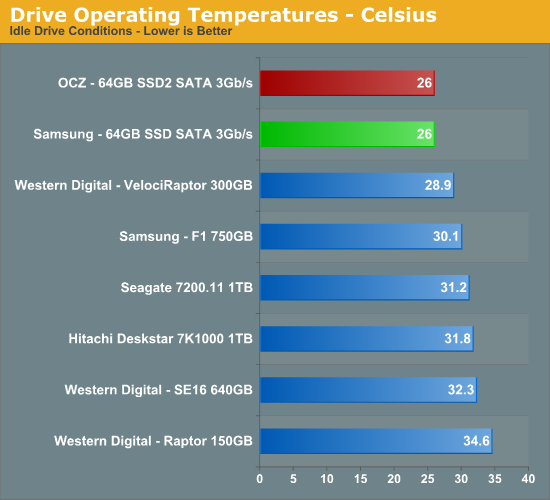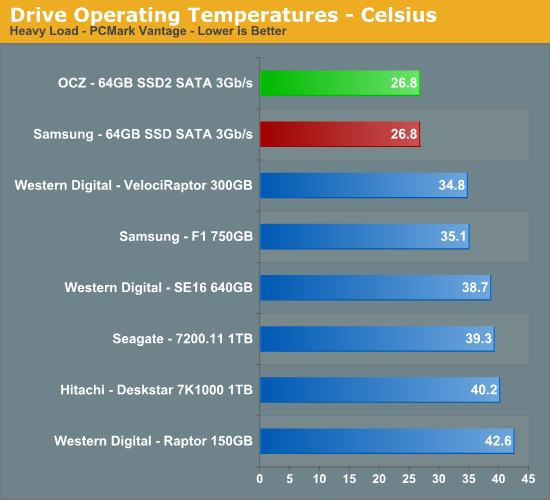64GB SSD on the Desktop: Samsung and OCZ go mainstream
by Gary Key on May 15, 2008 11:30 PM EST- Posted in
- Storage
Acoustics and Thermals
Our acoustic tests measure the decibel levels while the system is at idle and under load while running the Hard Disk test suite within PCMark Vantage. We take measurements at a distance of 5mm from the rear and front of the drive in a separate enclosure and report the highest reading. The test room has a base acoustical level of 20dB(A).
Since there are not any moving parts, the Solid State Drives are virtually silent and so we will bypass the results charts for this particular test.
Our thermal tests utilize sensor readings via the S.M.A.R.T. (Self-Monitoring, Analysis and Reporting Technology) capability of the drives as reported by utilizing the Active SMART 2.6 utility. We also utilize thermal sensors and infrared measurement devices to verify our utility results. We test our drives in an enclosed case environment. Our base temperature level in the room at the time of testing is 25C.


By way of its greatly reduced power dissipation, the Samsung/OCZ 64GB SSD leads our test group in both idle and load thermals thanks to the lack of mechanical parts.










38 Comments
View All Comments
Ender17 - Friday, May 16, 2008 - link
I'm not surprised. The 334 MB platter drives are fast.Just look at this review of the Samsung F1
http://www.storagereview.com/samsungs_spinpoint_f1...">http://www.storagereview.com/samsungs_spinpoint_f1...
Beats the old ADFD Raptors across the board. And I don't know why anyone expects the Seagate drives to be fast, they're consistently at the bottom in performance.
Griswold - Friday, May 16, 2008 - link
Why? It has the same platter density.Noya - Friday, May 16, 2008 - link
Yes, and I'm using my $59 WD 640gb just for games (the first 150gb of it anyway) and the load time is very quick compared to my old 250gb 7200.8 sata.PlasmaBomb - Friday, May 16, 2008 - link
Thats probably because your old drive was nearly full and speed drops off towards the inside of the platter.semo - Saturday, May 17, 2008 - link
aren't new data stored on the inside tracks of the platter and then move outwards?Zefram0911 - Friday, May 16, 2008 - link
Is anyone disappointed in the load times for games? Only beats my old raptors by 3-5 seconds.Calin - Tuesday, May 20, 2008 - link
Load time for game levels is mostly sequential - I suppose game developers take pains in having the load level as a big sequential read (in which case solid state drives have no advantage). I am surprised about the file compression tests (which have reads and writes from different areas of the disk)retrospooty - Friday, May 16, 2008 - link
"Is anyone disappointed in the load times for games? Only beats my old raptors by 3-5 seconds."Ya, I have to wonder what the various gaming tests like "Vantage HDD Gaming" are measuring. SSD's consistantly blow HDD's out of the water scoring 300 to 500% higher on those tests (Gary's article is consistent with others I have seen)... Then real world game load and level load times are only like 5% higher.
What gives?
lemonadesoda - Wednesday, May 21, 2008 - link
It's a very easy answer: file compression. The data files (e.g. maps and textures) on disk require a lot of CPU processing before they are "ready to play".A trick used in the days of Quake engines was to unzip the .pk3 files. Then delete the .pk3. This improved load times enormously.
Perhaps game designers should have an install option to "full unzip game asset data on install". It would require a lot more HDD space. But load times would shrink.
JarredWalton - Friday, May 16, 2008 - link
It's the nature of the benchmark: access a large amount of data in a fairly random fashion and don't do ANY processing of the data, and you end up with the theoretical performance of the hard drive. That's pretty much what IPEAK-based testing accomplishes.Games have been mostly bottlenecked by CPUs, GPUs, and RAM for a long time - load times with 2GB RAM are substantially faster than with 1GB of RAM, and even 4GB of RAM can show some speedup in certain newer games. The reason for the CPU bottleneck on level loads is that most games compress data in order to conserve space; decompressing all the textures and models and such takes a fair amount of CPU power, to the point where the hard drives probably only need to sustain around 15-25MB/s.